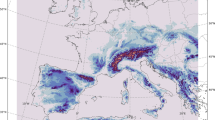Summary
The application of a radiative upper boundary condition (RUBC) in a mesoscale numerical weather prediction (NWP) model with hybrid vertical coordinate is presented. Results of two- and three-dimensional numerical simulations are discussed. Starting from earlier work by Klemp and Durran (1983) and Bougeault (1983) the radiative upper boundary condition is formally derived for a hybrid vertical coordinate. The basic assumptions include hydrostaticity, linearity, neglect of Coriolis effects and restriction to internal gravity waves. The resulting RUBC is global in space and local in time. In a second step. the RUBC is tested in a twodimensional vertical-plane version of the NWP model, in which essential properties of the full three-dimensional model have been preserved. Gravity wave experiments clearly show the superiority of the RUBC over the commonly used lid-type upper boundary condition. For the setting with an isolated bell-shaped mountain with resolution-independent steepness, the RUBC tends to work more effectively with increasing horizontal resolution. At the same time, the application of a radiative instead of a lid-type, and thus reflecting, upper boundary condition appears to become more important with decreasing mesh width. Finally, the RUBC is introduced into the full three-dimensional NWP model. This requires further approximations. In particular for a limited-area model, the geopotential field at the uppermost model level needs to be bi-periodic. Here, a linear detrending technique is applied. First results for a weather situation with strong northwesterly flow towards the Alps show that application of the RUBC drastically reduces the development of unrealistic standing, hydrostatic mountain waves, which become apprent as distinct mesoscale ridge-trough structures in the simulation with the lid-type upper boundary. Implications of the RUBC on the time-stepping procedure of the NWP model are also discussed. In the experiments whown, the additional RUBC-terms are treated explicitly.
Similar content being viewed by others
References
Binder, P., 1993: Personal communication.
Bougeault, Ph., 1983. A non-reflective upper boundary condition for limited-height hydrostatic models.Mon. Wea. Rev.,111, 420–429.
Bougeault, Ph., 1988: Simulations of orographic flows with a 10km-scale hydrostatic model. ECMWF, Workshop Proceedings: Techniques for horizontal discretization in numerical weather prediction models, 2–4 Nov., 1987, 229–247.
Davies, H. C. 1976: A lateral boundary formulation for multi-level prediction models.Quart. J. Roy. Meteor. Soc.,102, 405–418.
Davies, H. C., 1983: Limitations of some common lateral boundary schemes used in regional NWP models.Mon. Wea. Rev.,11, 1002–1012.
Doms, G., 1992: Description of a vertical slice model version of the “Europea-Model”. (personal manuscript).
Errico, R. M. 1985: Spectra computed from a limited area grid.Mon. Wea. Rev.,113, 1554–1562.
Herzog, H.-J., Doms, G., Majewski, D., 1992: Untersuchungen zur Bedeutung des hydrostatischen Trunkationsfehlers für mesoskalige Modelle.Annalen der Meteor.,27, 325.
Kållberg, P., 1977: Test of a lateral boundary relaxation scheme in a barotropic model. ECMWF, Research Department, Internal Report 3.
Klemp, J. B., Durran, D. R., 1983: An upper boundary condition permitting internal gravity wave radiation in numerical mesoscale models.Mon. Wea. Rev.,111, 430–444.
Klemp, J. B., Lilly, D. K., 1978: Numerical simulation of hydrostatic mountain waves.J. Atmos. Sci.,35, 78–107.
Lehmann, R., 1993: On the choice of relaxation coefficients for Davies' lateral boundary scheme for regional weather prediction models.Meteorol. Atmos. Phys.,52, 1–14.
Machenhauer, B., Haugen, J. E., 1988: Test of a spectral limited area shallow water model with time-dependent lateral boundary condition and combined normal modesemi Lagrangian time integration scheme. HIRLAM-Report, Kopenhagen, Aug., 1988, Preprint No. 4.
Majewski, D., 1991: The Europa-Modell of the Deutscher Wetterdienst. ECMWF, Seminar Proceedings: Numerical methods in atmospheric models, Vol. II, 9–13 September, 1991, 147–191.
Rasch, Ph. J., 1986: Toward atmospheres without tops: absorbing upper boundary conditions for numerical models.Quart. J. Roy. Meteor. Soc.,113, 1195–1218.
Simmons, A. J., Burridge, D. M., 1981: An energy and angular-momentum conserving vertical finite-difference scheme and hybride vertical coordinate.Mon. Wea. Rev.,109, 758–766.
Temperton, C., 1988: Implicit normal mode initialization.Mon. Wea. Rev.,116, 1013–1031.
WMO, 1993: Progress Report on Numerical Weather Prediction of Deutscher Wetterdienst, Germany. In: NWPP Report Series No. 19, WMO/TD No. 548, pp. 73–86.
Author information
Authors and Affiliations
Rights and permissions
About this article
Cite this article
Herzog, H.J. Testing a radiative upper boundar condition in a nonlinear model with hybrid vertical coordinate. Meteorl. Atmos. Phys. 55, 185–204 (1995). https://doi.org/10.1007/BF01029826
Received:
Revised:
Issue Date:
DOI: https://doi.org/10.1007/BF01029826




